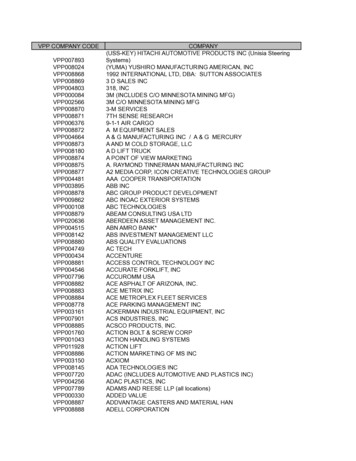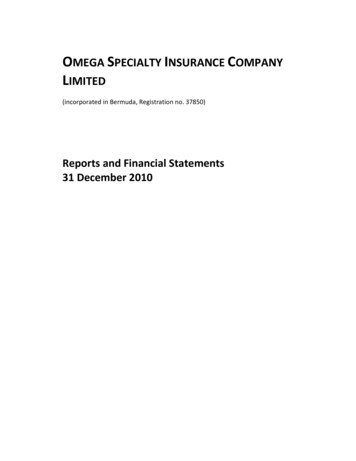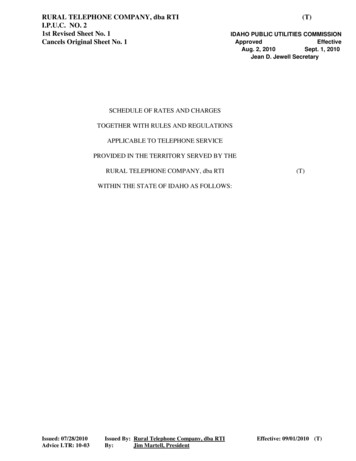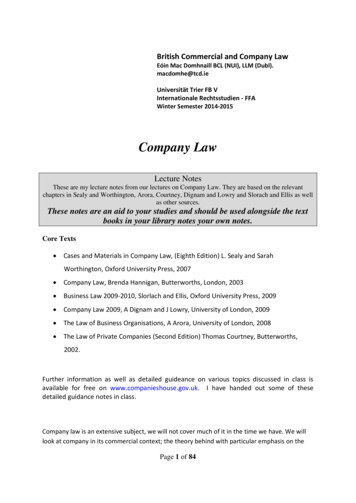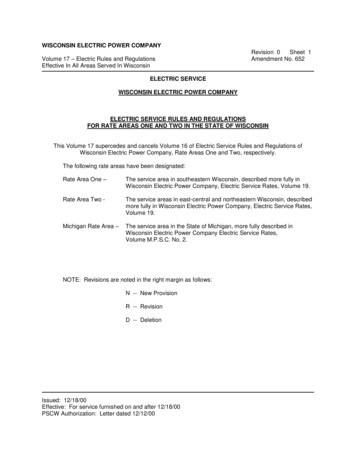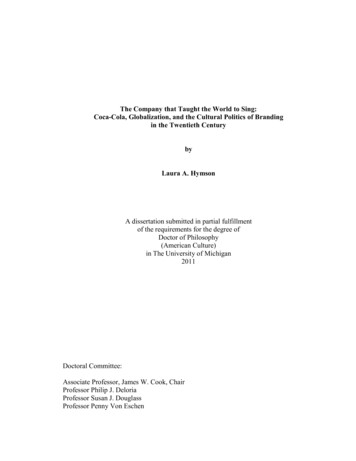
Transcription
The Company that Taught the World to Sing:Coca-Cola, Globalization, and the Cultural Politics of Brandingin the Twentieth CenturybyLaura A. HymsonA dissertation submitted in partial fulfillmentof the requirements for the degree ofDoctor of Philosophy(American Culture)in The University of Michigan2011Doctoral Committee:Associate Professor, James W. Cook, ChairProfessor Philip J. DeloriaProfessor Susan J. DouglassProfessor Penny Von Eschen
Laura A. Hymson2011
AcknowledgementsI owe an extraordinary debt to the people and institutions that helped andsupported me as I worked to complete this dissertation. While working on this project, Ispent time in several cities, including: Ann Arbor, New York, Atlanta, UrbanaChampagne, Alexandria, Washington, D.C, Newark, and Hartford. In all of these placeswhere I have lived, researched, or taught, I have been shown incredible kindness and I amgrateful for everyone who has helped me along the way.Thanks first to the chair of my dissertation committee, Jay Cook, who has beenexceptionally generous with his time. Without his insightful feedback, invaluable advice,and thoughtful comments this dissertation would not have been possible. I can only hopeto be as effective and compassionate as a teacher and mentor as he has been to me.My entire dissertation committee was composed of scholars whose work I trulyadmire and I am grateful for the time they devoted to my ideas and my work. Penny VonEschen and Phil Deloria provided important feedback on drafts, and made suggestions forresearch and writing that helped advance my thinking on a number key issues at the heartof this project. Susan Douglas offered critical input at a later stage, which served me wellin this stage of revisions and certainly will continue to going forward. Additionally,Marlene Moore, in the Program in American Culture, was a great help with fundingissues, endless paperwork, and last minute deadlines.ii
Several institutions provided support for this project, including financial support,office space, archival materials, and mentorship. Most recently, I was the Jackie McLeanFellow at the University of Hartford in the History Department. I would especially like tothank Warren Goldstein for his candid advice about successfully navigating academia.Thanks also to my mentor, Laurel Clark, who jumped right in on day one and read everyword of my dissertation. She helped me get to the finish line.The archivists and staff at the Manuscript, Archives, and Rare Book Library atEmory University helped me access their vast collection on Coca-Cola. Audrey P. Davis,the Assistant Director and Curator of the Alexandria Black History Museum, was aknowledgeable guide through the Moss Kendrix Collection. The John W. HartmanCenter for Sales, Advertising and Marketing History at Duke University and The GilderLehrman Institute of American History gave me generous funding for research.Additionally, the Mellon Mays Undergraduate Fellowship program, and the network ofMellon Fellows, has been an invaluable resource. Special thanks to Krishna Winston, theMellon program director at Wesleyan, who continually offered words of encouragement.I do not know if it was luck or fate, but I am truly grateful for my cohort inAmerican Culture. An extra special thank you goes to Erin Pipkin, Jan Bernabe, SarahGould, and Afia Ofori-Mensa. I learned so much from each of you, in and out of theclassroom. Most importantly, it was you who showed me that academia does not have tobe a lonely place, and that collaboration, not competition, is the best path towards thecreation of knowledge. Thanks also to an extended cohort that includes: Jason Chang,who continues to be my go-to person to talk through new ideas and remember old onesthat have slipped from memory; Nick Syrett, who shared his tiny apartment in Little Italyiii
and took “the long way” with me to Illinois which made the archives there much morefun; Will Mackintosh and Victoria Castillo, who helped convince me I am a historian;and Rachel Quinn, for a friendship and intellectual connection that has carried over fromcollege into graduate school. I might not have made it through that first winter, let alonecompleted a dissertation, but I did, thanks to your friendship and camaraderie.Without the love and support of my family I most certainly would not be where Iam today. My parents, Lena and Michael Hymson, my brothers, Mike Hymson and BradDavis, and my aunt Barbara Hymson encouraged me every step of the way. They instilleda love of learning and created opportunities for me to follow my curiosity and interests.At times of uncertainty, their unwavering belief in me kept me going. Thanks especiallyto my Mom, for the pep talks and Thai dinners. And my Dad, for his support and advice.Thank you to Leslie Rosenberg and Sara Pullen, two dear friends who are like family andhave always been there for me. Thank you to the entire Krauss family. To Jill who gradedmy WMST 101 papers as my TA at Wesleyan in 1996 and still helps with my writing.Thank you for your help along the way. Katie, Mike, Heidi, Allie, and Ethan, you notonly warmly welcomed me into your family but went above and beyond this past year byproviding me with a place to stay, masterful editing services, home cooked meals, andspectacular singing performances.And finally, thank you Sarah, for all that you do. Time spent with you and Ozziewas my favorite reward after more than a few very long days of writing. Your love,patience, and support made this journey not only bearable but meaningful. I might neverbe able to thank you enough, but I plan to try.iv
Table of ContentsAcknowledgements iiList of Figures . .viIntroduction . .1Chapter One:“The Drink That Makes the Whole World Kin”: Global Expansionand Alignment of the Coca-Cola Company and the U.S. NationState . . 30Chapter Two:“The Pause that Refreshes:” Coca-Cola’s Technical ObserverProgram Boosts Energy and Morale Around the World in theU.S. Armed Forces, 1942 1948 68Chapter Three:“The Global High-Sign”: Constructing a Global and Local Marketin Coca-Cola’s Domestic Wartime Advertising, 1943-1945. .106Chapter Four:The Color Line in the Cola Line:Coca-Cola’s Post-War Pursuit of the Negro Market . .147Chapter Five:“I’d Like to Buy the World a Coke”:Corporate Cosmopolitanism in the Global Marketplace, 1950-1971 .201ConclusionCoca-Cola’s Global Impact: 1886-1971 and Beyond .248Bibliography .261v
List of Figures1 Figure 1-1: Pemberton’s Coca Wine 342 Figure 1-2: Drink Ticket . 443 Figure 1-3: Promotional Serving Tray and Wall Clock 464 Figure 3-1: Brussels, 1945 1085 Figure 3-2: Alaska, 1943 .1226 Figure 3-3: Leyte, Philippines, 1945 .1277 Figure 3-4: You’re My Kind, 1944 .1328 Figure 3-5: Brazil, 1944 1339 Figure 3-6: Panama, China, and New Zealand, 1943-1944 .14110 Figure 3-7: Admiralty Isles, 1945 .14311 Figure 4-1: Refresh Yourself, 1925 15512 Figure 4-2: Refresh Yourself, 1924 15713 Figure 4-3: White Customers Only 18814 Figure 4-4: There’s Nothing Like a Coke .19515 Figure 5-1: World as Friend 20916 Figure 5-2: Greensboro Four, 1960 23017 Figure 5-3: Hilltop Commercial, Still Frame Image, No.1, 1971 .23718 Figure 5-4: Hilltop Commercial, Still Frame Image, No. 2, 1971 .238vi
IntroductionSince the Yankees came to Trinidad \ They got the young girls all goin’ mad.The young girls say they treat them nice \ Make Trinidad like paradise.Drinkin' rum and Coca-Cola \ Go down Point Koo-mah-nah;Both mother and daughter \ Workin' for the Yankee dollar.– The Andrews Sisters, “Rum and Coca- Cola” (1944)With its infectious calypso rhythms, the Andrew Sisters’ hit song, “Rum andCoca-Cola,” enthralled American audiences during World War II. Nearly 40 years later,Maxine Andrews recalled that the group thought the lyrics were “cute” and that the group“didn't think of what it meant . . . because we weren't as morally open as we are todayand so . . . [the meaning of the lyrics] just went over our heads.”1 The song was populardespite implicit references to alcohol, prostitution, and questionable moral behavior fromAmerican soldiers. Some radio stations refused to play the song because it amounted tofree advertising for the Coca-Cola Company – which actually had no involvement increating the song. None of this, however, stopped the song from growing in popularity.During the Andrew Sisters United Service Organizations (USO) tours during World WarII (WWII), “Rum and Coca-Cola” was their most requested song. American GIs called it“the national anthem of the GI camps.”2 The song stayed at number one on Billboard’s12“Maxine Andrews interviewed by Jim Harlan” (WNEW-AM Radio, February 1992).John Sforza, Swing It!: The Andrews Sisters Story, 2nd ed. (The University Press of Kentucky, 2004), 71.1
U.S. Pop Singles chart for ten weeks in 1945. This calypso hit with racy lyrics becamepopular with troops on military bases, as well as with civilians on the home front.3Another kind of controversy surrounding the song was reported in a Timemagazine article later that year. The question was asked: Who really wrote the lyrics andmusic to “Rum and Coca-Cola”? In fact, a singer named Jeri Sullivan was the first toperform the song in the U.S. Sullivan, in turn, claimed to have picked it up from MoreyAmsterdam, a radio comedian who passed through Trinidad as part of a USO camp show.Sullivan, partnering with a music publisher named Leo Feist, got permission from theCoca-Cola Company to publish the song as sheet music, record it, and then perform itlive. The Time article, however, correctly identified Rupert W. Grant, a calypso singernicknamed “Lord Invader,” as the person who originally wrote the lyrics in 1943. Hissong, it turned out, had been copyrighted in Trinidad, and a published booklet containingthe lyrics was entered into evidence during the copyright infringement suit that soonensued. Five years later, Lord Invader won his case.4The original lyrics were slightly different and more explicit than the ones madepopular by the Andrew Sisters. Following the line "The young girls say they treat 'emnice,” the Andrews Sisters sang “Make Trinidad like paradise.” Lord Invader, bycontrast, ended with a more explicit image: “and they give them a better price.”3For Billboard statistics, see Joel Whitburn, Joel Whitburn’s Pop Hits 1940-1954: Singles and Albums, 2nded. (Record Research Inc., 2002), 308. Sales figures for the song were published in Variety (December 25,1946), 35. For more on the trio’s experiences during their wartime tours, see Sforza, Swing It!, 76.4“Coca in Calypso,” Time, January 29, 1945. Sullivan and Feist were not concerned about copyright, butrather the rights to the trademarked brand name “Coca-Cola.” For an overview of Invader's career see JohnCowley's introduction to the compilation album, "God Made Us All - Lord Invader: The Asch Recordings".Invader recorded for the Decca music label in Trinidad in 1939 and again in 1940. In 1941 Invader came toNew York for the first time and recorded for Decca there. Decca was also the recording label that put outthe Andrews Sisters version of the song. Kevin Burke have compiled a complete account of the Rum andCoca-Cola controversy and the lawsuits that followed in “The Rum and Coca-Cola Reader”, aCola/main.html.2
Promiscuity and prostitution, in short, were far clearer in Lord Invader’s original version.The song reflected life as he had experienced it on the island. When asked in 1946 aboutthe role of Calypso in Trinidad and his inspiration for the song, Lord Invader explainedCalypso is the folklore of Trinidad, a style of poetry, telling about current eventsin song. Back home . . . I was traveling on a bus, someplace they call PointCumana, a bathing resort, and I happened to see the G.I.s in the American socialinvasion in the West Indies, Trinidad. You know the girls used to get the candiesand stuff like that, and they go to the canteens with the boys and so on, have fun.So I noticed since the G.I.s came over there . . . They drink rum, and they likeCoca-Cola as a chaser, so I studied that as an idea of a song, and MoreyAmsterdam had the nerve to say that he composed that song back here.5Lord Invader’s memory of the “social invasion” of the GIs in Trinidad spoke to theAmerican military occupation that began in 1940. Three years later, approximately20,000 “Yankee soldiers” were stationed in Trinidad, a major operation that reshaped lifeon the island, including a local economy that catered to the troops and provided themwith Rum and Coca-Cola and Trinidadian women.6My dissertation examines the twofold process embedded in this long-forgottenepisode: first, how Coca-Cola found its way to foreign markets like Trinidad; and secondhow images of Coca-Cola’s global circulation became increasingly pervasive in5Lord Invader, “People’s Songs, Inc., ‘Calypso at Midnight’” (presented at the The Midnight Special,Town Hall (New York, NY), December 21, caCola/Town Hall.html.6Lt. Robert A. Johnston and Capt. James C. Shoultz, Jr., “Unpublished Manuscript: History of the TrinidadSector and Base Command”, 1947, Center for Military History, United States Army, Washington, D.C.;Stetson Conn, Rose C. Engelman, and Byron Fairchild, “The Caribbean in Wartime,” in Guarding theUnited States and its Outposts (Washington, D.C.: Center for Military History, United States Army, 2000),http://www.history.army.mi
in Coca-Cola’s Domestic Wartime Advertising, 1943-1945. .106 Chapter Four: The Color Line in the Cola Line: Coca-Cola’s Post-War Pursuit of the Negro Market . .147 Chapter Five: “I’d Like to Buy the World a Coke”: Corporate Cosmopolitanism in the Global Marketplace, 1950-1971 .201
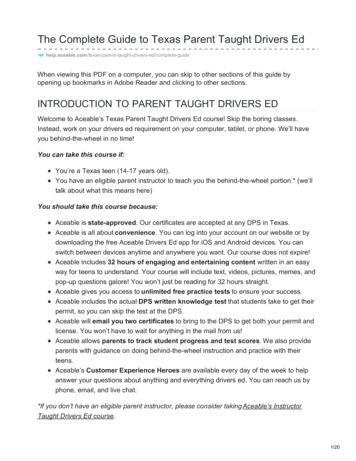
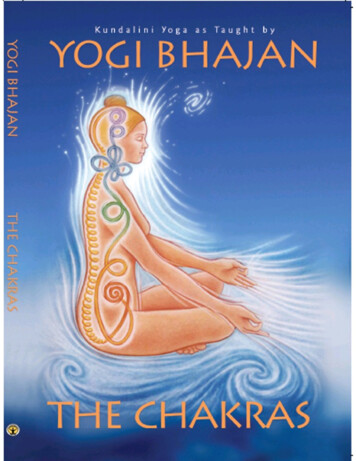


![Shareholders’ Agreement of [Company name] company. 1 .](/img/1/startup-founders-sha-sample.jpg)
